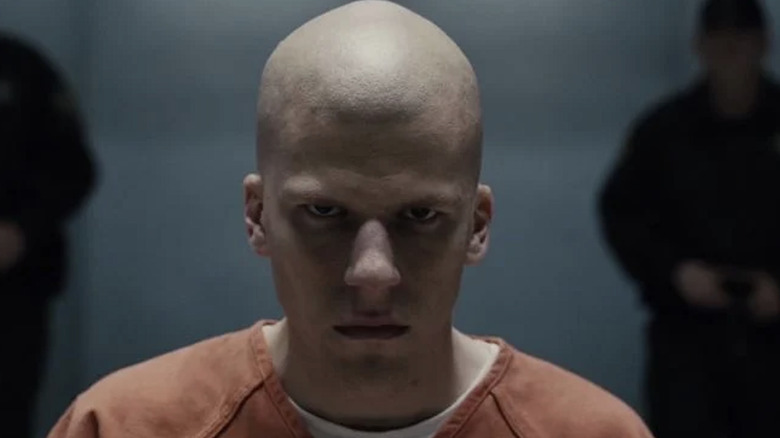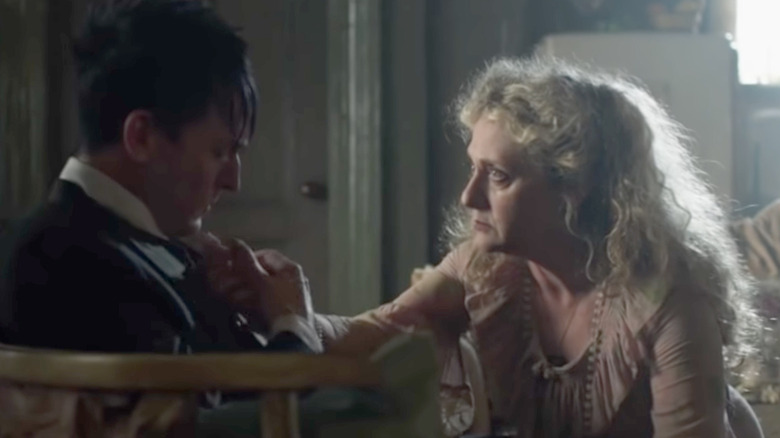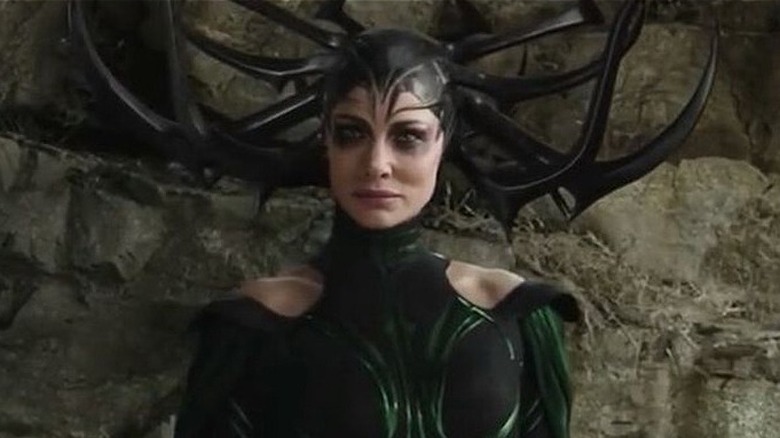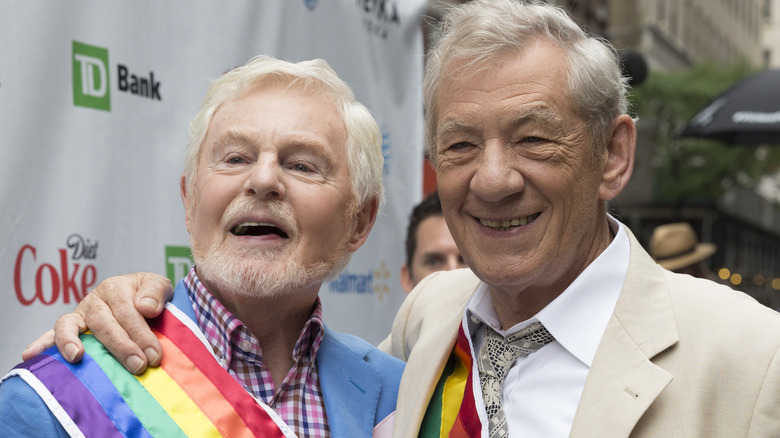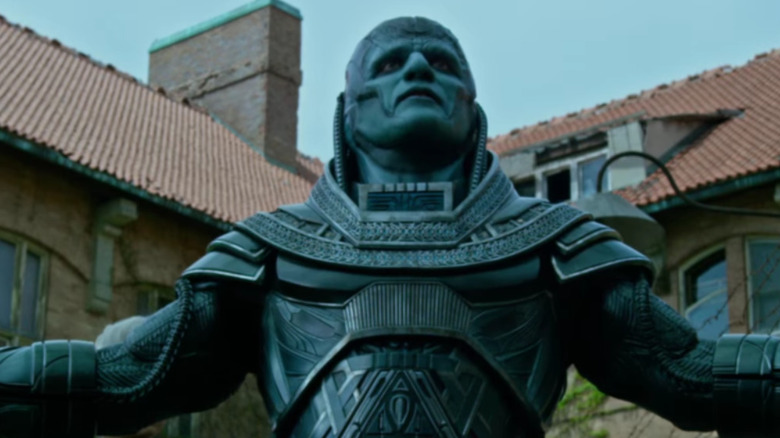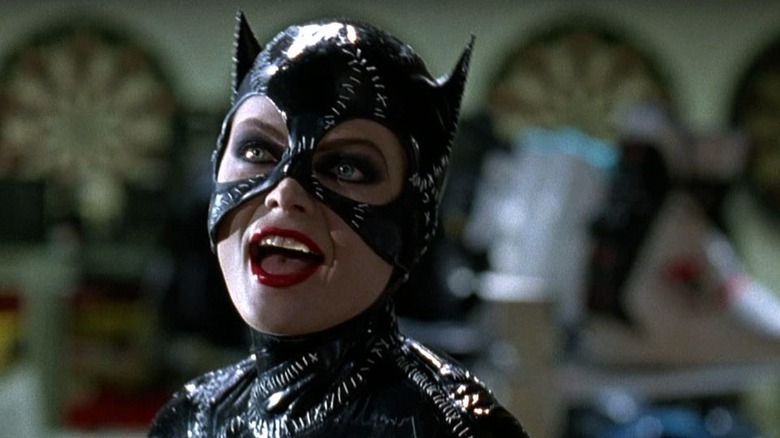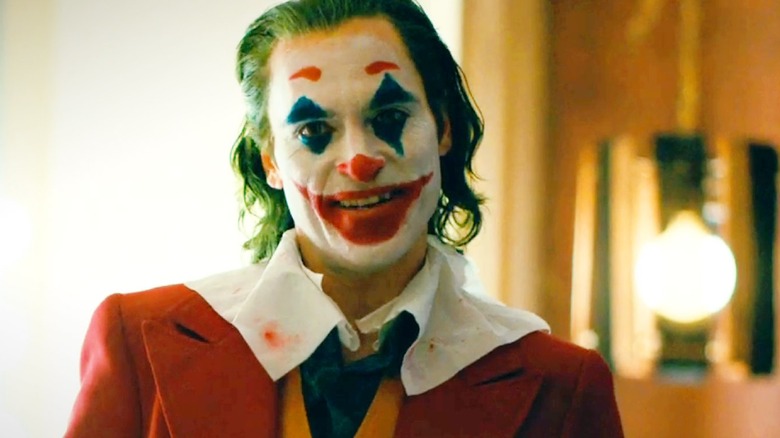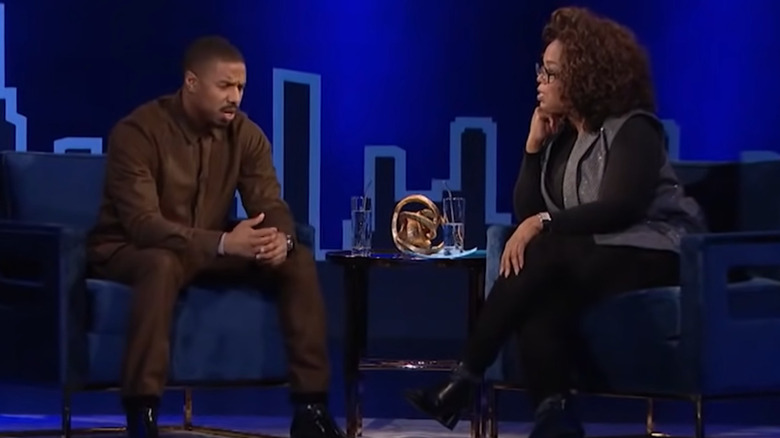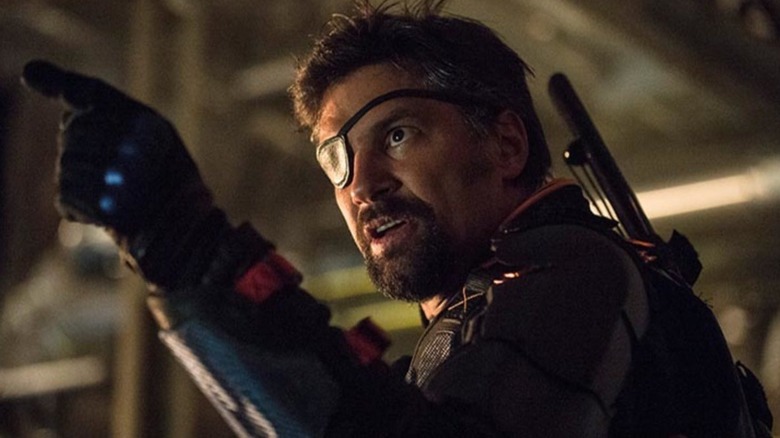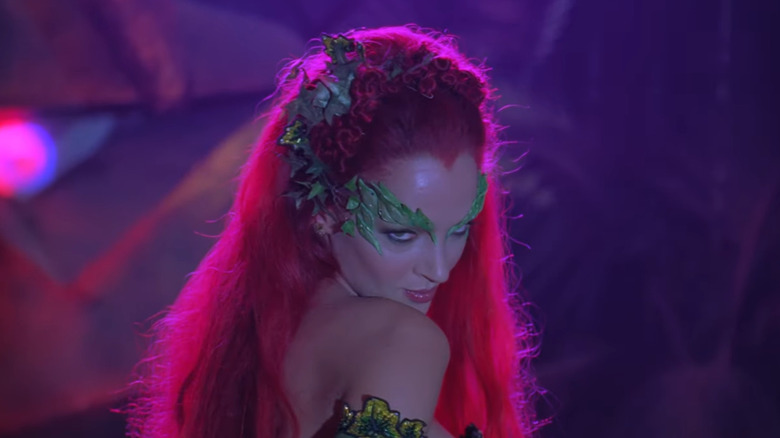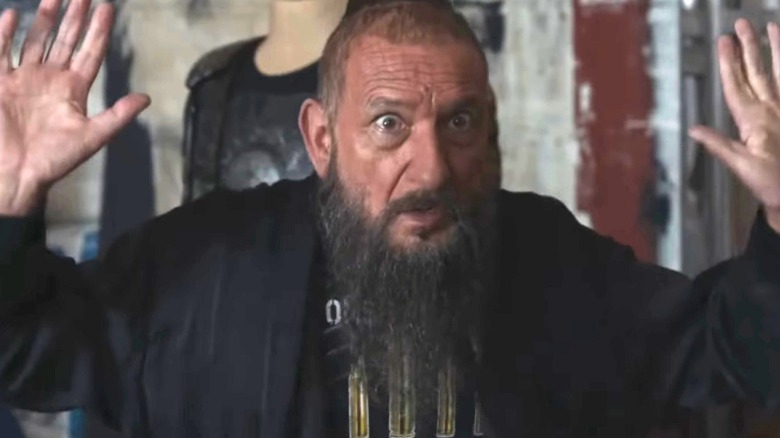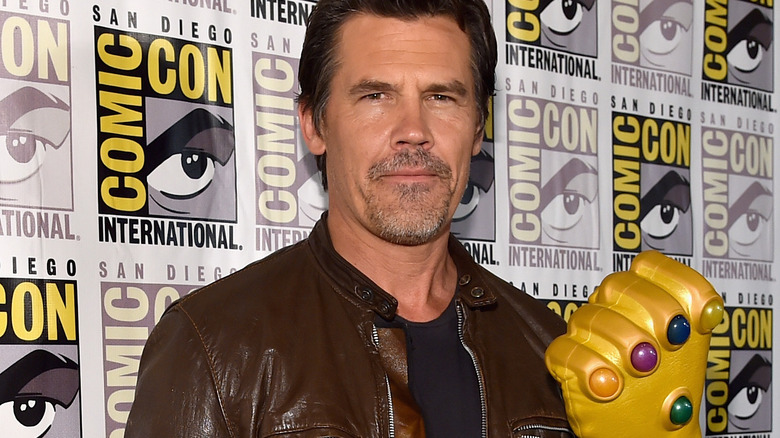Rules Supervillain Actors Must Follow
It's hard to deny these days that in the entertainment world, superheroes reign supreme, raking in billions of dollars at the box office, earning their own special corners of HBOMax and Disney+, and all but taking over the CW. But superheroes are only as good as their supervillains, even though for too long the bad guys were treated as little more than plot devices.
Thankfully, that has changed, and the villains are finally getting respect — such as when DC upgraded Bane from mindless, juiced-up lackey in "Batman & Robin" to tortured, city-ending menace in "The Dark Knight Rises." Marvel went from underwhelming baddies like Whiplash in "Iron Man 2" (Serious question: Can anyone remember what the guy's deal was?) to Thanos, whose drive to wipe out half the universe because of overpopulation was so compelling that it got a number of pretty intelligent folks asking: Was Thanos right? Then there are the supervillains stepping out from under the shadow of their heroic counterparts. Venom, Joker, Loki, even Black Adam are all flying solo and holding down their own movies and TV series.
It's no wonder, then, that supervillain roles these days are attracting some of the biggest actors in the industry — though they don't always know what they're getting into. It's not always as glamorous as the heroes who get top billing, but do it right and the bad guys can outshine the good. Here, then, are some rules for actors if they want to play unforgettable supervillains.
Dive into the comic books
When it comes to acting, research is a crucial part of any role. In the superhero world, that research entails reading comic books — lots and lots of comic books. When Robin Lord Taylor played a young version of the Penguin in "Gotham," he veered away from the short, rotund villain with a fondness for trick umbrellas popularized by portrayals like Danny DeVito in "Batman Returns."
"Gotham" featured a new breed of Penguin — younger, thinner, less in-control, and less gimmicky. This Penguin was supposed to be more grounded in reality. "We're taking this fantastic world," Taylor told Esquire in 2014, "and trying to make it something that everyone can identity with. That's definitely the goal for me — bringing the realistic aspect to these people."
Realistic wasn't exactly what writers were going for when they created a villain obsessed with bird crimes and sword umbrellas, but that didn't mean the comics were useless. Then-CCO of DC Entertainment, Geoff Johns, picked out a number of comic books to help Taylor get a feel for his character. It was just a matter of finding the right material. Instead of tales of Penguin's supervillain antics, Taylor dove into stories of Penguin's childhood. "That really helped solidify the character as a person as opposed to an archetype," he noted. At the end of the day, it doesn't matter whether the supervillain is faithful to the source material or branches out in new directions — the comic books are still king.
Put a unique spin on the villain
Unlike heroes, supervillains aren't always that well known or rigidly defined. That relative obscurity affords a greater freedom for actors to put a unique stamp on their characters — something that's needed to make your mark in a world where we can get three different Jokers over the course of a decade. As Cate Blanchett told Collider in 2017, the "deep, hardcore fan base" may know her "Thor: Ragnarok" villain Hela, but the actress knew virtually nothing about the Goddess of Death when she got the role. That, strangely enough, proved a boon, as the blank slate let her approach Hela from new angles.
"I threw a lot of ideas into the ring with [director Taika Waititi] and with the Motion Capture people and the Special Effects crew," Blanchett told Collider. "What if I shot this out? What if I play with my cape? Could stuff come out of that? It's been an organic thing [and] quite loose actually." It also gave her the chance to draw inspiration from those who'd already put their spin on the character. "When I was starting to think about how she might look, I went back to the fanbase," Blanchett explained to Yahoo! Entertainment as the film was being released. "All these girls were doing Hela makeup looks on YouTube. I spoke to Marvel about what she would look like when she would be unmasked, so she wasn't a faceless, generic baddie. They were very open to everything."
Find a personal connection with your villain
No one likes a one-dimensional villain, nor one played by an actor who isn't invested in the role. That's how we get forgettable villains like Malekith from "Thor: The Dark World." Despite being played by the talented Christopher Eccleston, the character just wasn't interesting and the actor, as he told the Guardian in 2018, hated everything about the movie.
Contrast him with someone like Magneto, played by Sir Ian McKellen, and it's night and day. Magneto himself is a complex villain, but McKellen was able to imbue him with a poignant humanity because he understood the survivor. "'X-Men' is about what it's like to be an outsider," McKellen told Playbill in 2018. "It's about what it's like to be different from everyone else, and what it's like to have the majority pointing fingers at you and saying, 'You're different,' or even that you're inferior. Obviously, that relates to the experience of a lot of gay people."
In his documentary, "McKellen: Playing The Part" the actor talks about how activists are usually split between the calm, peaceful protestors like Professor X and the reactionaries like Magneto. "In any civil rights movement, there's an argument between that and the Magneto character," the actor explains. "[Magneto] says we'll fight to the bitter end, we're proud of our differences and may be violent in our defense." McKellen, of course, has been fighting for gay rights since he came out back in 1988, so he understands activism — and Magneto — on an intimate level.
The costumes are really uncomfortable
If an actor signs up for a superhero movie, one thing they absolutely have to be ready for is wrestling with an unwieldy costume. Comic books are rarely drawn with real life in mind, and characters are often just given costumes that look cool in whatever time period they are designed. While heroes tend to be enamored with comfy spandex and tights, villains can get ... well, complicated. Just look at "X-Men: Apocalypse," and the pretty tame X-Men suits compared to the monstrosity that Apocalypse had to wear. It certainly caught the villain's portrayer, Oscar Isaac, by surprise — and not in a good way.
"Apocalypse, that was excruciating," Isaac noted without hesitation during a 2018 GQ interview. "I didn't know when I said yes that that was what was going to be happening, that I was going to be encased in glue and latex, and in a 40-pound suit that I had to wear a cooling mechanism at all times." He couldn't move, he couldn't turn his head, and he couldn't even see the actors he was working with. "Getting it off was the worst part, because they just had to kind of like scrape it off for hours and hours."
It sounds like an excruciating, miserable experience — but at least that didn't keep Isaac from diving back into the comic book world for Marvel's "Moon Knight" on Disney+. Thankfully, Moon Knight is much more of a form-fitting, flowing-robes kinda guy — a hero's costume that is likely much more to the actor's taste.
Don't fight the costume, work it
In the annals of difficult super costumes, Michelle Pfeiffer's Catwoman suit for "Batman Returns" has to be up there as one of the most notoriously difficult to wear. "They had to powder me down, help me inside and then vacuum-pack the suit," Pfeiffer recalled in 2017 to CinemaBlend. "I had those claws, and I was always catching them in things. The face mask was smashing my face and choking me ... we had a lot of bugs to work out." But they did work the bugs out, and that suit is now looked back upon as iconic.
Pfeiffer learned how to not just act in the costume, but with it. The film's costume designer, Mary Vogt, says the actress didn't just take to the costume, she mastered it. "Michelle moves beautifully, and she was just a perfect fit for that costume," Vogt told AnOther in 2012. "Because you can see everything — and the latex makes it look very fluid, and Michelle just has a beautiful, fluid way of working — she's very athletic, so she gave it a modern look."
The costumes are probably going to be pretty uncomfortable no matter what, but as Vogt put it, "At the end of the day, you're helping the actor create the character." Once actors understand that, they can make any supervillain costume work with them, instead of against them.
Be ready to go to some dark places
As varied as supervillains can be, at the end of the day, actors have to know that they're playing a bad guy. Whether nuanced and tortured or just plain psychotic and evil, these characters spring forth from the dark corners of the soul. When you're trying to bring these villains to life, getting into those dark corners can be a pretty big mind-scramble.
Just ask Joaquin Phoenix, who prepared for playing Arthur Fleck in "Joker" by reading up on political assassins and losing a shocking amount of weight. "As it turns out," Phoenix told ET Canada in 2019, "that impacts your psychology, and you really start to go mad when you lose that much weight in that amount of time." He also really dug into Arthur's mind and emotions, adding that over the course of filming, "every day felt like we were discovering new aspects of the character and shades of his personality, up until the very last day."
That discovery, though, appears to have taken a toll, as Phoenix reportedly got intense. Director Todd Phillips told the New York Times upon the film's release that, "In the middle of the scene, he'll just walk away and walk out. And the poor other actor thinks it's them and it was never them — it was always him, and he just wasn't feeling it." It may have been a brutal process for everyone, but you can't argue with the results that painted a villain so real, psychiatrists are analyzing him.
Don't get lost in the role
Sometimes it's easier to get into a character than out of one. Supervillains can be particularly tough to shake, whether we're talking about Phoenix's Joker or Michael B. Jordan's Killmonger. Jordan's "Black Panther" performance as the tortured villain blew both critics and fans away, earning him a slew of awards and nominations. The actor, however, ended up paying a price.
"To be able to take that kind of pain and rage and all those emotions that Erik kind of represents from being black and brown here in America," Jordan explained to Oprah Winfrey on "SuperSoul Sunday" in 2019, "that was something I didn't take lightly." He didn't have a set plan for getting to that place, admitting that he just did what he had to every day to inhabit it as long as he could.
As Winfrey put it, when it comes to acting and inhabiting a character and a scene, "Even though you're playing this character, sometimes the essence of that, the energy of that still remains." Jordan agreed "1000 percent" and admitted that he didn't have an "escape plan" when he finished filming. He was depressed and had a hard time reconnecting with the people who loved him. The actor said he wasn't sure when exactly he got himself back, but he did end up going to therapy to help him work through the pain he took into himself while playing Killmonger.
The supervillain will always lose
One of the quirks of comic books (that folks find either comforting or boring) is that while there may be setbacks, losses, and failures, in the end, the good guy always wins. Any actor playing a supervillain needs to make peace with this. Manu Bennet, who played Deathstroke on "Arrow" learned this the hard way when he left the show unhappy with how his villain ended up.
"I think Deathstroke had a lot of possibilities with 'Arrow,'" he told The Music in 2015, "but I think they took it in the wrong direction. I think they should have honored the Marv Wolfman character who was literally unstoppable. It took the Justice League to defeat him; it took an army to take him on. In 'Arrow,' it took a while for Oliver [Queen/Arrow] to prove his point, but [Season 3] was just a beating of Slade, adding insult to injury." But that's just the way it is. It's so common, in fact, that the trope is called "villain decay." The bad guys appear unstoppable the first time they're seen, only to become weaker as time goes on, until the hero is able to defeat them.
Ultimately, even though Bennet was unhappy happy when he left, it seems there were no hard feelings. He made peace with Deathstroke's de-powering enough to bring the redeemed villain back to "Arrow" for a bit in Season 5.
Sell the role no matter what
While comic book movies and TV shows may be in the middle of a renaissance right now, let's be honest: Not all of them are high art. When dealing with supervillains who often operate on their own bizarre logic — enough with the monologue, just kill the hero and you'll win! — a lot of times all that saves the character is an actor's ability to sell it. When it came to playing Poison Ivy in "Batman & Robin," for instance, Uma Thurman knew exactly what movie they were filming and how to play her role, and she has never stopped selling it. While everyone from George Clooney to the film's late director, Joel Schumacher, have apologized for the movie, Uma Thurman has consistently defended it.
Thurman was taking Mae West and "playing with it," she told HuffPost in an interview back in 2014. As for that campiness that everyone derides? "I think at the time the idea of taking a male superhero and having fun with it and someone using the c-word [campy] on it caused people to be very nasty," she explained. "They didn't like seeing that tone applied to their heterosexual male icon." And it worked. Dig into film reviews like this one from the New York Times and you'll see what little praise was thrown around was often for Thurman's campy Poison Ivy. If an actor sells their role and the movie, they can make even the most outlandish villain work.
Fan backlash is a very real possibility
Casting is just the first fan hurdle actors have to make it over when they take on a role in a superhero project. Fans tend to feel very strongly about these characters that they love and read about month after month. Hell, Michael Keaton's "Batman" casting, Christian Bale's Dark Night and Heath Ledger's iconic Joker all faced initial backlash. More often than not, however, the performances win over even the doubters.
Playing the supervillain, though, comes with some extra baggage, because even if an actor really delivers a standout performance and gives viewers a hateful character, that hatefulness can backfire. That's what happened with Sir Ben Kingsley's performance in "Iron Man 3." When he was announced as Iron Man's archenemy The Mandarin, it seemed brilliant. Surely someone of Kingsley's caliber would deliver a standout performance. And he did — it just wasn't the performance fans were expecting.
His "Mandarin" turned out to be a drunk actor named Trevor Slattery — nothing but a distraction from the real villain, Aldrich Killian. Folks were not happy. Marvel Studios co-president, Louis D'Esposito admitted in an IGN interview in 2013 to being somewhat surprised.
"We thought there would be a little bit of a backlash," he said, "but the twist was so wonderful, and Sir Ben Kingsley's such a great actor, we thought that would overcome [the anger]." For many, it didn't, but hopefully the haters are feeling a bit better now that Marvel used "Shang-Chi and the Legend of the Ten Rings" to redeem the character.
Comfort zones are challenged
Gimmicks, super powers, bizarre costumes and dark backstories — a supervillain is a character like no other. Which is why actors need to be ready to step outside their comfort zones to tackle these unique roles. Josh Brolin admitted to CBR in 2016 that in the past he'd shied away from plenty of "bigger-type movies," but the thought of playing Thanos and taking on all the Avengers convinced him to try something a bit different.
After he decided to take the leap into the juggernaut of the MCU, he still had to adjust to the technical aspects of Thanos' CGI. Even though he had a bit of experience doing mo-cap filming, "it was," he told CBR, "really unnerving for me in the beginning."
Still, speaking to the Team Deakins podcast in 2020, Brolin explained that as much as playing the Mad Titan was outside of his usual comfort zone, he embraced it and thought, "If I can have focus during this process, I can do anything. And that became the challenge for me." With all the bizarre technical requirements and stretches of imagination required to do a CGI villain, it was definitely a challenge. Brolin admitted that it took some time to get into the right acting space for Thanos, "purely out of nerves." But "the more I watched it, the more I realized this is a real guy. This is not a big purple guy. This is a guy with insides and cells and feelings. Then, it became fun."
